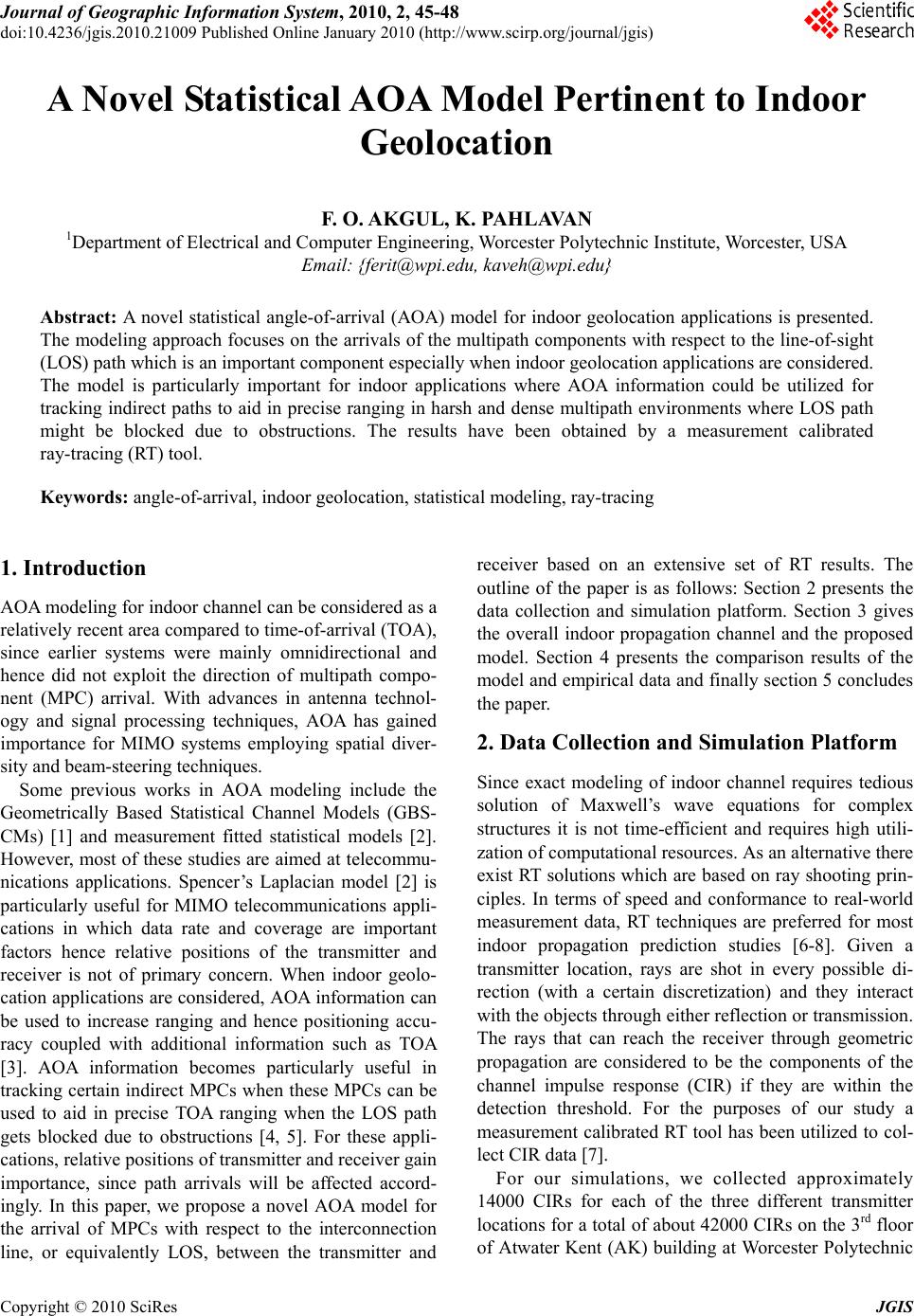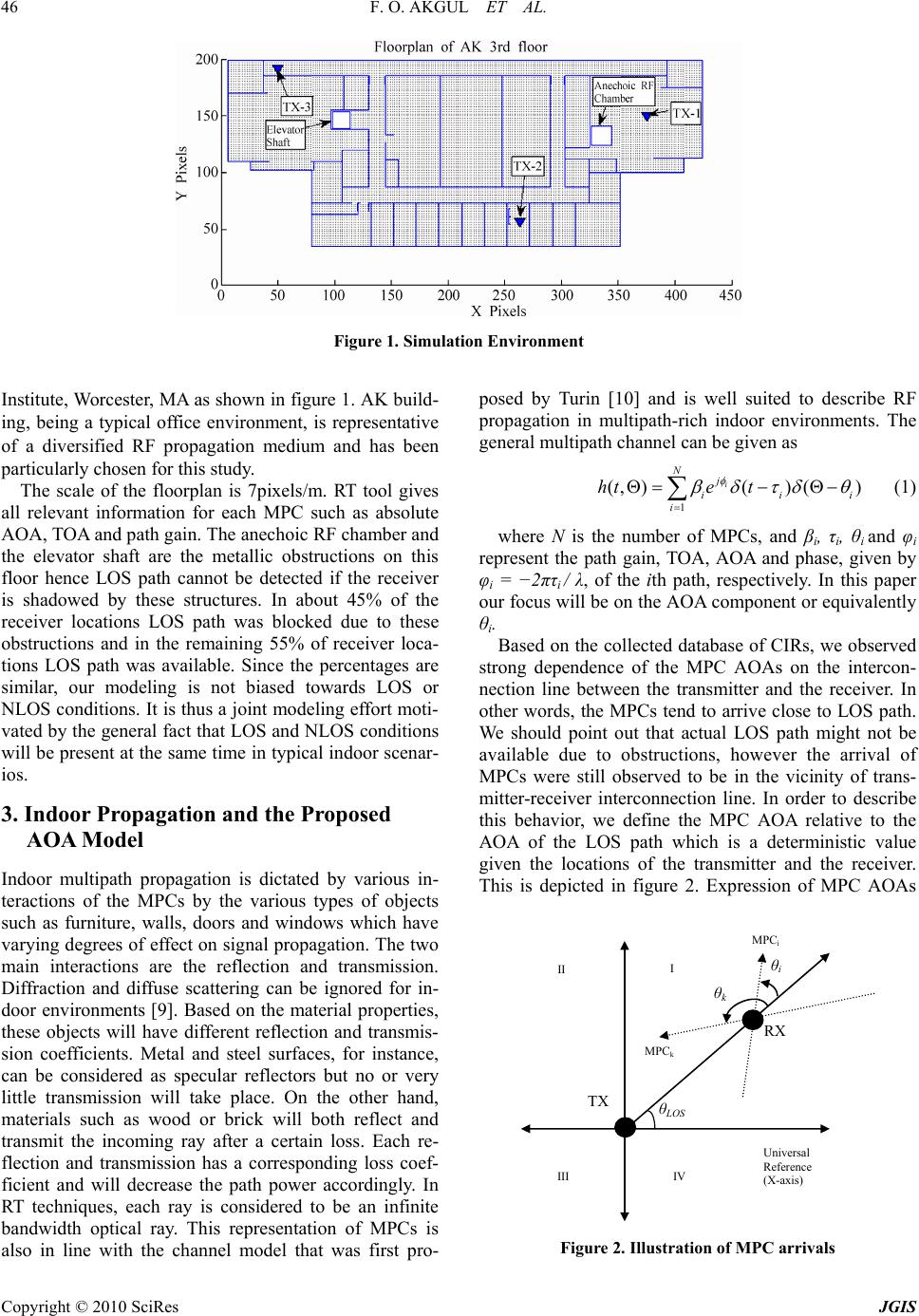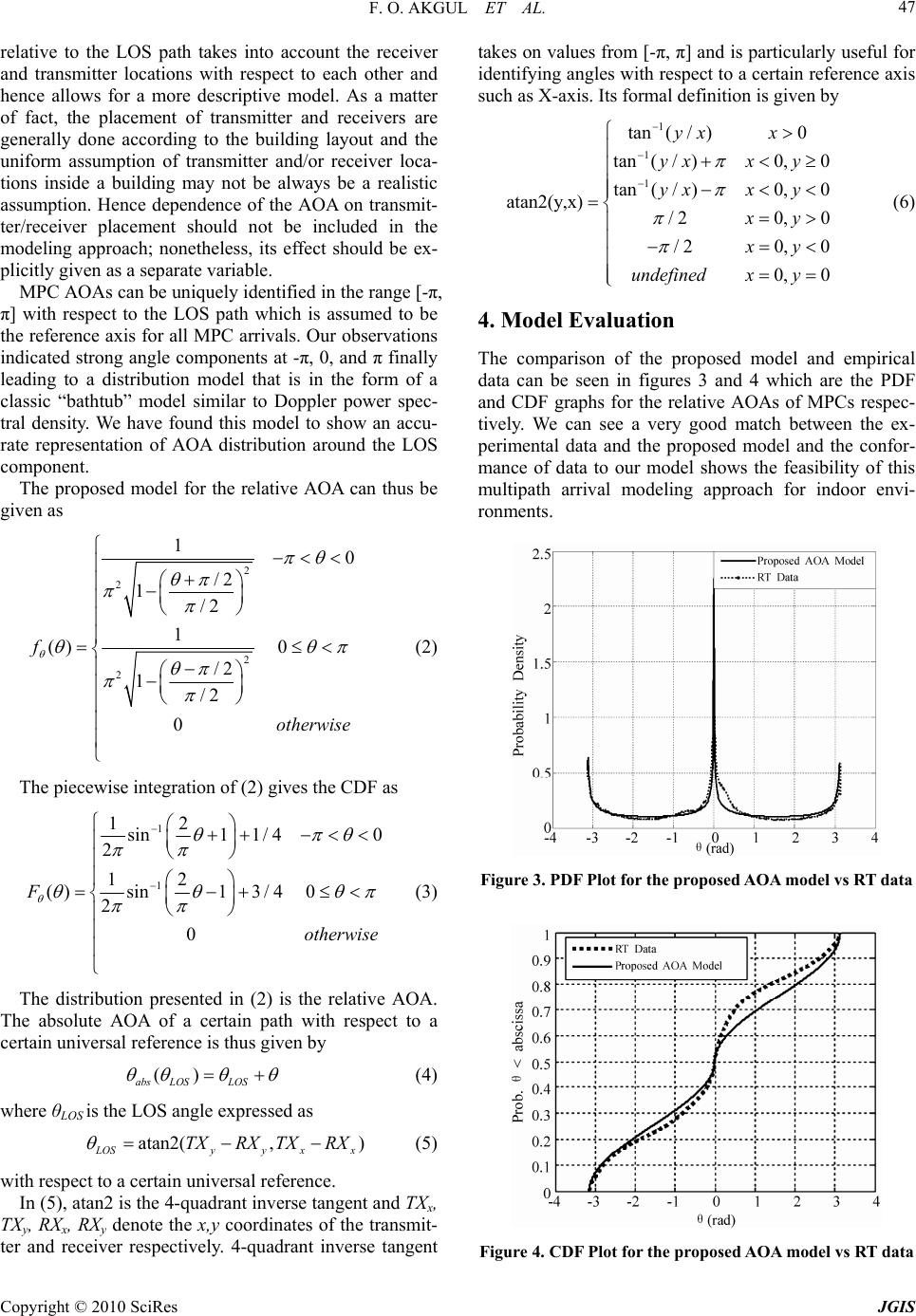Paper Menu >>
Journal Menu >>
 Journal of Geographic Information System, 2010, 2, 45-48 doi:10.4236/jgis.2010.21009 Published Online January 2010 (http://www.scirp.org/journal/jgis) Copyright © 2010 SciRes JGIS A Novel Statistical AOA Model Pertinent to Indoor Geolocation F. O. AKGUL, K. PAHLAVAN 1Department of Electrical and Computer Engineering, Worcester Polytechnic Institute, Worcester, USA Email: {ferit@wpi.edu, kaveh@wpi.edu} Abstract: A novel statistical angle-of-arrival (AOA) model for indoor geolocation applications is presented. The modeling approach focuses on the arrivals of the multipath components with respect to the line-of-sight (LOS) path which is an important component especially when indoor geolocation applications are considered. The model is particularly important for indoor applications where AOA information could be utilized for tracking indirect paths to aid in precise ranging in harsh and dense multipath environments where LOS path might be blocked due to obstructions. The results have been obtained by a measurement calibrated ray-tracing (RT) tool. Keywords: angle-of-arrival, indoor geolocation, statistical modeling, ray-tracing 1. Introduction AOA modeling for indoor channel can be considered as a relatively recent area compared to time-of-arrival (TOA), since earlier systems were mainly omnidirectional and hence did not exploit the direction of multipath compo- nent (MPC) arrival. With advances in antenna technol- ogy and signal processing techniques, AOA has gained importance for MIMO systems employing spatial diver- sity and beam-steering techniques. Some previous works in AOA modeling include the Geometrically Based Statistical Channel Models (GBS- CMs) [1] and measurement fitted statistical models [2]. However, most of these studies are aimed at telecommu- nications applications. Spencer’s Laplacian model [2] is particularly useful for MIMO telecommunications appli- cations in which data rate and coverage are important factors hence relative positions of the transmitter and receiver is not of primary concern. When indoor geolo- cation applications are considered, AOA information can be used to increase ranging and hence positioning accu- racy coupled with additional information such as TOA [3]. AOA information becomes particularly useful in tracking certain indirect MPCs when these MPCs can be used to aid in precise TOA ranging when the LOS path gets blocked due to obstructions [4, 5]. For these appli- cations, relative positions of transmitter and receiver gain importance, since path arrivals will be affected accord- ingly. In this paper, we propose a novel AOA model for the arrival of MPCs with respect to the interconnection line, or equivalently LOS, between the transmitter and receiver based on an extensive set of RT results. The outline of the paper is as follows: Section 2 presents the data collection and simulation platform. Section 3 gives the overall indoor propagation channel and the proposed model. Section 4 presents the comparison results of the model and empirical data and finally section 5 concludes the paper. 2. Data Collection and Simulation Platform Since exact modeling of indoor channel requires tedious solution of Maxwell’s wave equations for complex structures it is not time-efficient and requires high utili- zation of computational resources. As an alternative there exist RT solutions which are based on ray shooting prin- ciples. In terms of speed and conformance to real-world measurement data, RT techniques are preferred for most indoor propagation prediction studies [6-8]. Given a transmitter location, rays are shot in every possible di- rection (with a certain discretization) and they interact with the objects through either reflection or transmission. The rays that can reach the receiver through geometric propagation are considered to be the components of the channel impulse response (CIR) if they are within the detection threshold. For the purposes of our study a measurement calibrated RT tool has been utilized to col- lect CIR data [7]. For our simulations, we collected approximately 14000 CIRs for each of the three different transmitter locations for a total of about 42000 CIRs on the 3rd floor of Atwater Kent (AK) building at Worcester Polytechnic  F. O. AKGUL ET AL. Copyright © 2010 SciRes JGIS 46 Figure 1. Simulation Environment Institute, Worcester, MA as shown in figure 1. AK build- ing, being a typical office environment, is representative of a diversified RF propagation medium and has been particularly chosen for this study. The scale of the floorplan is 7pixels/m. RT tool gives all relevant information for each MPC such as absolute AOA, TOA and path gain. The anechoic RF chamber and the elevator shaft are the metallic obstructions on this floor hence LOS path cannot be detected if the receiver is shadowed by these structures. In about 45% of the receiver locations LOS path was blocked due to these obstructions and in the remaining 55% of receiver loca- tions LOS path was available. Since the percentages are similar, our modeling is not biased towards LOS or NLOS conditions. It is thus a joint modeling effort moti- vated by the general fact that LOS and NLOS conditions will be present at the same time in typical indoor scenar- ios. 3. Indoor Propagation and the Proposed AOA Model Indoor multipath propagation is dictated by various in- teractions of the MPCs by the various types of objects such as furniture, walls, doors and windows which have varying degrees of effect on signal propagation. The two main interactions are the reflection and transmission. Diffraction and diffuse scattering can be ignored for in- door environments [9]. Based on the material properties, these objects will have different reflection and transmis- sion coefficients. Metal and steel surfaces, for instance, can be considered as specular reflectors but no or very little transmission will take place. On the other hand, materials such as wood or brick will both reflect and transmit the incoming ray after a certain loss. Each re- flection and transmission has a corresponding loss coef- ficient and will decrease the path power accordingly. In RT techniques, each ray is considered to be an infinite bandwidth optical ray. This representation of MPCs is also in line with the channel model that was first pro- posed by Turin [10] and is well suited to describe RF propagation in multipath-rich indoor environments. The general multipath channel can be given as 1 (,)() () i N j iii i hte t (1) where N is the number of MPCs, and βi, τi, θi and φi represent the path gain, TOA, AOA and phase, given by φi = −2πτi / λ, of the ith path, respectively. In this paper our focus will be on the AOA component or equivalently θi. Based on the collected database of CIRs, we observed strong dependence of the MPC AOAs on the intercon- nection line between the transmitter and the receiver. In other words, the MPCs tend to arrive close to LOS path. We should point out that actual LOS path might not be available due to obstructions, however the arrival of MPCs were still observed to be in the vicinity of trans- mitter-receiver interconnection line. In order to describe this behavior, we define the MPC AOA relative to the AOA of the LOS path which is a deterministic value given the locations of the transmitter and the receiver. This is depicted in figure 2. Expression of MPC AOAs MPC i MPC k θk θi RX TX θLOS I II III IV Universal Reference (X-axis) Figure 2. Illustration of MPC arrivals  F. O. AKGUL ET AL. Copyright © 2010 SciRes JGIS 47 relative to the LOS path takes into account the receiver and transmitter locations with respect to each other and hence allows for a more descriptive model. As a matter of fact, the placement of transmitter and receivers are generally done according to the building layout and the uniform assumption of transmitter and/or receiver loca- tions inside a building may not be always be a realistic assumption. Hence dependence of the AOA on transmit- ter/receiver placement should not be included in the modeling approach; nonetheless, its effect should be ex- plicitly given as a separate variable. MPC AOAs can be uniquely identified in the range [-π, π] with respect to the LOS path which is assumed to be the reference axis for all MPC arrivals. Our observations indicated strong angle components at -π, 0, and π finally leading to a distribution model that is in the form of a classic “bathtub” model similar to Doppler power spec- tral density. We have found this model to show an accu- rate representation of AOA distribution around the LOS component. The proposed model for the relative AOA can thus be given as 2 2 2 2 10 /2 1/2 1 () 0 /2 1/2 0 f otherwise (2) The piecewise integration of (2) gives the CDF as 1 1 12 sin11/ 40 2 12 ()sin13/4 0 2 0 F otherwise (3) The distribution presented in (2) is the relative AOA. The absolute AOA of a certain path with respect to a certain universal reference is thus given by () abs LOSLOS (4) where θLOS is the LOS angle expressed as atan2( ,) L OSyy xx TXRX TXRX (5) with respect to a certain universal reference. In (5), atan2 is the 4-quadrant inverse tangent and TXx, TXy, RXx, RXy denote the x,y coordinates of the transmit- ter and receiver respectively. 4-quadrant inverse tangent takes on values from [-π, π] and is particularly useful for identifying angles with respect to a certain reference axis such as X-axis. Its formal definition is given by 1 1 1 tan (/ )0 tan (/ )0,0 tan (/ )0,0 atan2(y,x) /20, 0 /20, 0 0, 0 yx x yxx y yxx y xy xy undefinedx y (6) 4. Model Evaluation The comparison of the proposed model and empirical data can be seen in figures 3 and 4 which are the PDF and CDF graphs for the relative AOAs of MPCs respec- tively. We can see a very good match between the ex- perimental data and the proposed model and the confor- mance of data to our model shows the feasibility of this multipath arrival modeling approach for indoor envi- ronments. Figure 3. PDF Plot for the proposed AOA model vs RT data Figure 4. CDF Plot for the proposed AOA model vs RT data  F. O. AKGUL ET AL. Copyright © 2010 SciRes JGIS 48 5. Conclusion In this paper, we have proposed a novel statistical indoor AOA model. The main difference of this model from previous models is the relative modeling of multipath arrivals with respect to the interconnection line between the transmitter and the receiver. Hence a more descrip- tive distribution of arrival angles is obtained given the transmitter and receiver locations. This model is particu- larly useful in situations where direct path is blocked due to certain obstructions and multipath AOA information can be utilized together with TOA for high precision ranging. REFERENCES [1] P. Petrus, J. H. Reed, T. S. Rappaport, “Geometri- cal-based statistical macrocell channel model for mobile environments”, IEEE Transactions on Communications, vol. 50, no. 3, pp. 495–502, March 2002. [2] Q. Spencer, “Modeling statistical time and angle of arri- val characteristics of an indoor multipath channel”, IEEE Journal on Selected Areas in Comm., vol. 18, no. 3, Mar 2000. [3] F. O. Akgul, K. Pahlavan, “AOA Assisted NLOS Error Mitigation for TOA-Based Indoor Positioning Systems”, IEEE Military Communications Conference, Orlando FL, 29-31 Oct. 2007. [4] K. Pahlavan, F. O. Akgul, M. Heidari, A. Hatami, J. M. Elwell, R. D. Tingley, “Indoor geolocation in the absence of direct path”, IEEE Wireless Communications, vol. 13, no. 6, pp. 50-58, Dec 2006. [5] D. E. Gustafson, J. M. Elwell, J. A. Solt, “Innovative Indoor Geolocation Using RF Multipath Diversity”, In IEEE/ION Position, Location, And Navigation Sympo- sium, pp. 904-912, San Diego, CA, April 25-27, 2006. [6] R. Valenzuela, “A ray tracing approach to predicting in- door wireless transmission”, in Proc. IEEE VTC 1993, pp. 214–218, Piscataway, NJ, May 18-20, 1993 [7] T. Holt, K. Pahlavan, J. F. Lee, “A computer graphics package for indoor radio channel simulation using a 2D ray tracing algorithm”, In Proc. Local Computer Net- works, Minneapolis, MN, September 13-16, 1992 [8] T. Holt, K. Pahlavan, J. F. Lee, “A graphical indoor radio channel simulator using 2D ray tracing”, In Proc. of the Third International IEEE Symposium on Personal, In- door and Mobile Radio Communications, Boston, MA, October 19-21, 1992. [9] H. Bertoni, W. Honcharenko, L. R. Maciel, and H. Xia, “Uhf propagation prediction for wireless personal com- munications”, In Proc. of the IEEE, vol. 82, no. 9, pp. 1333–1359, Sep 1994. [10] G. L. Turin et al., “A statistical model of urban multipath propagation”, IEEE Transactions on Vehicular Technol- ogy, vol. 21, no. 1, pp. 1–9, Feb 1972. |

